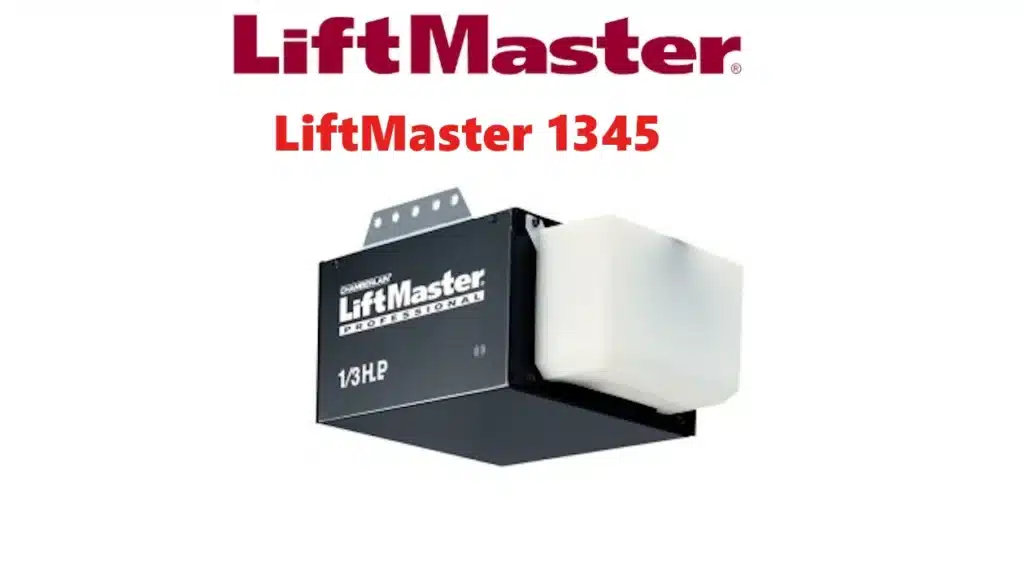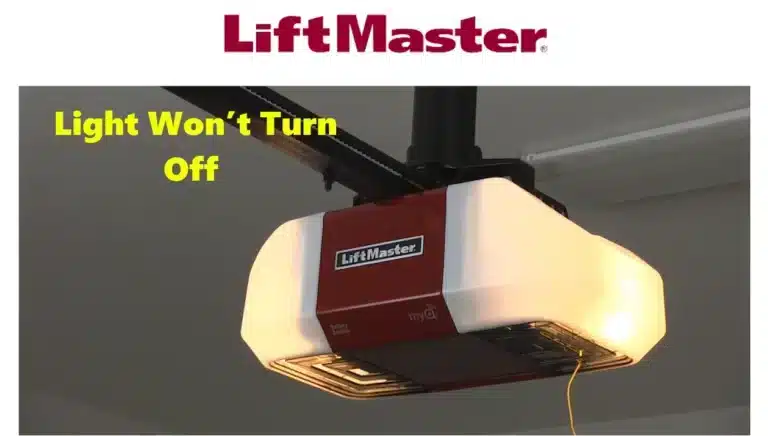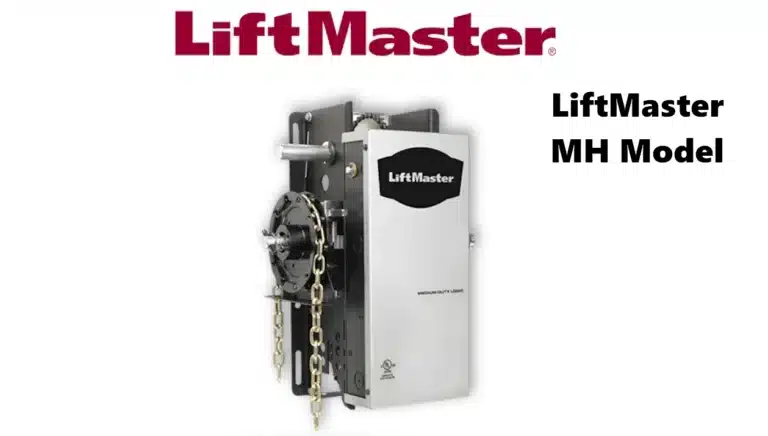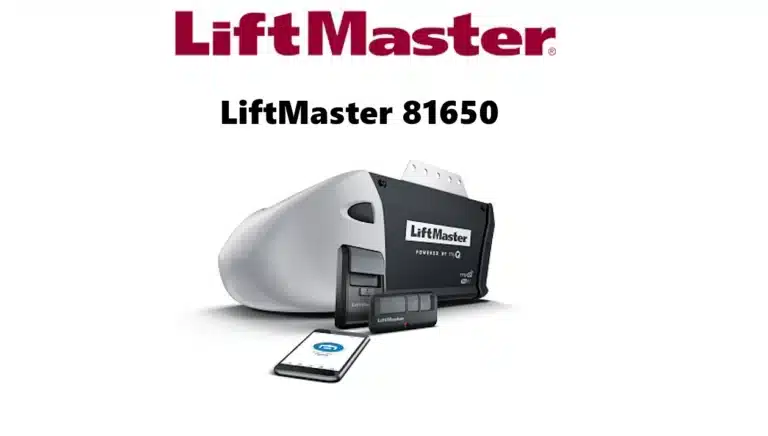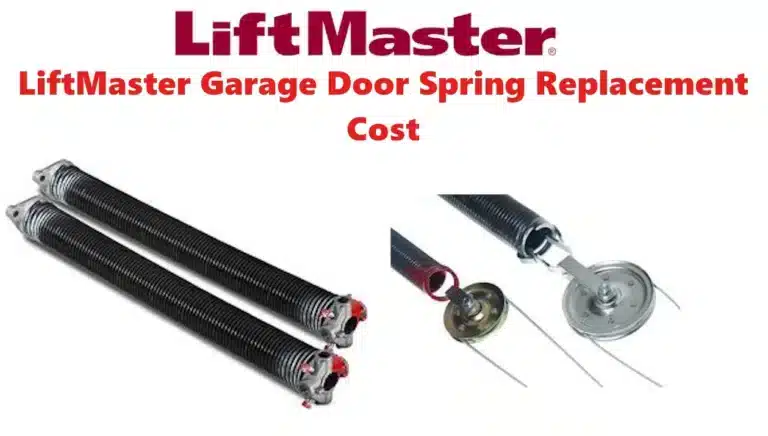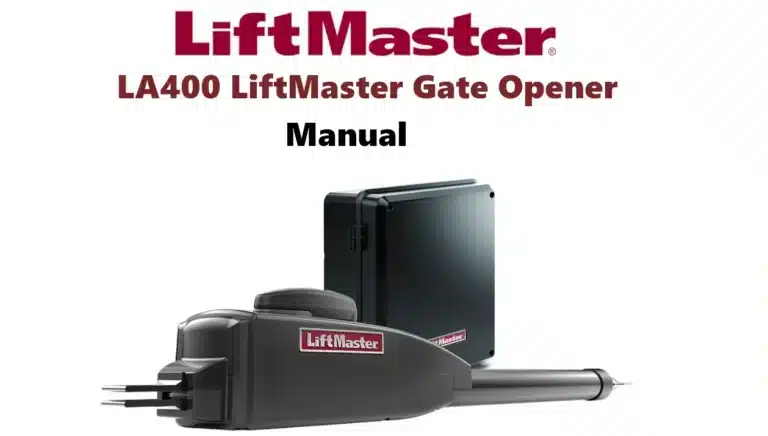The LiftMaster 1345 is an entry‑level garage door opener from the mid‑2000s. It belongs to LiftMaster’s Contractor Series, a line of no‑frills products aimed at people who value reliability and affordability. With a chain‑drive system and a modest 1/3 horsepower (HP) AC motor, the 1345 doesn’t boast the smart features of today’s units. Instead, it delivers steady, dependable performance for single‑car garage doors. This article highlights the key features, specifications, advantages and drawbacks of the LiftMaster 1345 to help homeowners decide if it suits their needs.
LiftMaster 1345 Overview and Key Features
The LiftMaster 1345’s design focuses on function over form. Its 1/3 HP motor operates at about 1,625 rpm and is protected by automatic thermal overload protection. A full‑length chain connects the motor’s drive sprocket to a trolley that moves along a solid‑steel T‑rail. This system is rugged and widely used in commercial and residential openers. The opener supports a single light bulb up to 75 watts and provides about 4.5 minutes of illumination after the door operates. An included Security+® remote uses rolling‑code technology to send a unique code each time it is pressed, giving the 1345 modern‑style security despite its age.
| Specification | Detail | Source |
|---|---|---|
| Motor | 1/3 HP AC, ~1,625 rpm, thermal protect | |
| Drive mechanism | Full chain on solid‑steel T‑rail | |
| Lighting | Single bulb up to 75 W, ~4.5 min delay | |
| Remote system | Security+® rolling code, ~150 ft range | |
| Safety sensors | Infrared beam reversal and obstruction detection | |
| Locking system | PosiLock® mechanical door lock | |
| Maximum door opening | 7 ft 6 inches (10 ft with optional rail) |
These specifications illustrate why the LiftMaster 1345 has enjoyed a long service life: it provides essential functions without complexity. While it doesn’t offer smartphone connectivity or soft‑start/stop features, it delivers the basics reliably.
LiftMaster 1345 Garage Door Opener Owner’s Manual
Why a 1/3 HP Chain‑Drive Fits Certain Homes
Choosing a garage door opener starts with horsepower. Industry guides advise that 1/3 HP motors are best for smaller, single‑car doors made of lightweight materials like aluminum or thin wood. Heavier, insulated doors generally require a ½‑HP or ¾‑HP motor. Because the LiftMaster 1345 uses a chain drive, it can still handle moderate loads, but it is not meant for heavy double‑door applications. In practice, homeowners with detached garages or lightweight doors find its 1/3 HP motor adequate, especially in milder climates where cold doesn’t add resistance.
The chain‑drive mechanism contributes to the opener’s strength and cost‑effectiveness. Chain drives are durable and capable of lifting heavier doors than belts. However, they have inherent downsides: noise and vibration, periodic lubrication and maintenance, and a slightly jerky motion compared with belt drives. For homes with bedrooms adjacent to the garage, belt‑drive units may be better because of their quiet operation. Homeowners prioritizing budget and lifting strength often pick chain‑drive models like the 1345 over more expensive belt‑drive units.
Safety and Security
Even though the LiftMaster 1345 is a basic opener, it meets the UL325 safety standard and incorporates several important safety features:
- The Protector System® uses two infrared sensors mounted near the floor. If something breaks the beam, the door automatically reverses to prevent injury .The opener’s light also turns on when the beam is broken.
- Sensing technology in the motor’s logic board stops the door if it makes contact with an obstruction.
- Security+® rolling code remote ensures a fresh code is sent with every button press, reducing the risk of code grabbing.
- PosiLock® mechanical lock keeps the door locked when closed, resisting forced entry.
- Manual release handle allows the door to be disengaged and operated manually during power outages.
These systems give the 1345 safety capabilities comparable to more modern openers, even though it lacks smart‑home controls.
Installing the LiftMaster 1345
Preparation
Installation requires basic carpentry tools: a ladder, level, drills, wrenches and screwdrivers. Before starting, ensure the garage door is balanced and operating smoothly by hand. Disconnect power to existing openers and remove old hardware.
Key Steps
- Assemble the rail and chain. The LiftMaster 1345 arrives in two cartons: one for the opener head and accessories, and one for the solid‑steel rail. Attach the chain and trolley to the rail according to the manual.
- Install the header bracket above the door’s center line and attach the front of the rail. LiftMaster states the fully assembled opener is about 124 inches long, so verify clearance from the header to the back wall.
- Hang the opener from ceiling joists using angle iron or perforated strap. Make sure it is level and well‑supported.
- Connect the door arm, adjusting the angles so the door opens fully without straining the motor. With optional rails, the opener can handle doors up to 10 feet tall.
- Wire the controls and sensors. Run low‑voltage wires to the wall control button and the Protector System® sensors. Mount sensors facing each other about 6 inches from the floor.
- Plug in the opener and program travel limits. Set the up and down travel stops so the door fully opens and closes, then adjust force settings to ensure proper reversal when an obstruction is detected.
Professional vs DIY
A mechanically inclined homeowner can install the LiftMaster 1345. However, professional installation ensures that the opener meets local codes and that door springs are correctly balanced. Incorrect spring tension can overload a 1/3 HP motor. A professional can also advise if your door is too heavy for the 1345 and suggest a more powerful model.
Comparing LiftMaster 1345 to Other Openers
Chain vs Belt vs Screw Drives
- Chain‑drive units, like the 1345, are durable and handle heavier doors but are noisy and require periodic lubrication.
- Belt‑drive openers use reinforced rubber belts and operate much more quietly; the All Security Equipment blog notes they produce a “remarkably quiet operation ideal for attached garages”. They cost more and may not be rated for very heavy doors.
- Screw‑drive openers use a threaded steel rod; they offer faster opening speeds and moderate noise but are less common today. LiftMaster has phased out many screw‑drive models in favour of belt drives.
Horsepower Considerations
Horsepower determines how easily the opener lifts a door. A 1/3 HP opener like the 1345 suits single‑car doors made from lightweight materials. A ½ HP unit is the go‑to for standard two‑car doors, while ¾ HP or 1 HP models are needed for heavy wooden or insulated doors. Over‑sizing the motor does not harm the door but under‑sizing can shorten the opener’s life.
Cost and Features
The LiftMaster 1345’s simplicity results in a lower price than premium models. It lacks Wi‑Fi, battery backup and soft‑start/stop, features now common in modern openers. But replacement parts like remotes and sensors remain widely available. Homeowners looking to save money or keep a detached garage functional often choose this model for its affordability and reliability.
Pros and Cons of the LiftMaster 1345
Advantages
- Dependable performance. Multiple sources describe the 1345 as offering dependability combined with reliability. Its chain drive and steel components have proven durable over years of use.
- Cost‑effectiveness. As part of the Contractor Series, the 1345 provides core features at a budget‑friendly price.
- Strength for light doors. The chain drive delivers adequate torque for single‑car doors. When the door is balanced, the 1/3 HP motor performs reliably.
- Straightforward controls. Programming the wall control and remote is simple, and there are no complicated menus or apps to navigate.
- Widely available parts. Remotes, sensors and rails can still be purchased from hardware stores or online.
Disadvantages
- Noise and vibration. Chain drives produce more noise than belt drives, which may disturb occupants if the garage is attached to living space.
- Limited horsepower. The 1345 is not ideal for heavy doors or extremely cold climates. Under‑powered motors can wear out quickly when overworked.
- No smart features. There is no Wi‑Fi connectivity, battery backup or soft‑start/stop. Upgrading to a modern opener offers convenience and extra safety.
Ideal Use Cases
The LiftMaster 1345 is best suited to:
- Detached garages or workshops where noise is less of a problem.
- Single‑car doors made from aluminum or uninsulated steel, up to 7 feet 6 inches high.
- Budget‑conscious homeowners or property managers needing reliable basic functionality.
- DIY enthusiasts who enjoy installing and maintaining their own equipment.
Maintenance and Longevity
Regular maintenance keeps a chain‑drive opener running smoothly. Lubricate the chain and rail every six months to reduce noise. Periodically check the door balance and adjust springs if the door doesn’t stay open halfway. Clean and align the safety sensors, and test the reversal system by placing a piece of wood under the door. If the opener hesitates or stops prematurely, adjust the travel limits. Most problems—such as a blinking light when the door won’t close—can be traced to misaligned sensors or depleted remote batteries. When major components such as gears or logic boards fail, weigh the cost of repair against replacing the entire opener with a newer model.
Upgrading or Keeping the LiftMaster 1345
Technology has advanced since the 1345’s release. Newer LiftMaster openers use DC motors, which offer softer start and stop, and integrate Wi‑Fi for smartphone control. Many models also include battery backups to meet California’s safety regulations. Upgrading delivers convenience and peace of mind but comes at a cost. Conversely, sticking with a functioning 1345 saves money and avoids unnecessary complexity. Because replacement parts are available, you can keep an older unit running for years. Ultimately the choice depends on your priorities: quiet operation and smart features versus cost savings and simplicity.
Conclusion
The LiftMaster 1345 embodies a bygone era of garage door openers—an affordable chain‑drive workhorse that delivers reliable performance without modern bells and whistles. Its 1/3 HP motor and solid chain drive make it suitable for lightweight, single‑car doors, providing homeowners with dependable operation at a modest price. Safety features like the Protector System®, Security+® rolling codes and PosiLock® mechanical lock meet important safety standards. Despite its age, the 1345 remains a solid option for detached garages and budget‑conscious users. Those who require quieter operation, smart‑home integration or battery backup may prefer newer models, but for basic dependability the LiftMaster 1345 continues to hold its own.
Frequently Asked Questions (FAQs) about the LiftMaster 1345
What doors are compatible with the LiftMaster 1345?
The 1345 is designed for single‑car garage doors constructed from lightweight materials like aluminum or thin wood. Industry guides note that 1/3 horsepower openers are best suited to these lighter doors. The opener’s chain drive adds lifting strength, but it is not meant for heavy insulated double‑car doors. If your door is exceptionally heavy or taller than 7 ft 6 inches, you should either use the optional 10‑ft rail kit or choose a more powerful 1/2‑HP or 3/4‑HP model.
How do you program the LiftMaster 1345 remote and wall control?
Programming the Liftmaster remote control and wall button is straightforward. First, locate the learn button on the opener’s motor head—press and release it; the indicator light will glow for 30 seconds. Within this window, press and hold the button on your Security+® remote until the opener’s lights flash. This confirms the remote is paired. To program a wall‑mounted control, follow the same process: hold the desired button while pressing the learn button on the opener. The 1345 uses rolling‑code technology, so each remote transmission sends a unique code for enhanced security.
What are common LiftMaster 1345 troubleshooting steps?
If your LiftMaster 1345 stops working or behaves erratically, start with basic checks. Make sure the garage door moves smoothly by hand; an unbalanced door can overload a 1/3‑HP motor and cause shutdowns. Inspect the Protector System® sensors; misaligned or dirty lenses can prevent the door from closing. Replace the remote’s battery and verify the wall control’s wires are secure. If the door reverses unexpectedly or stalls, adjust the travel and force limits according to the manual. Many failures are caused by simple issues such as misaligned sensors or depleted batteries, so homeowners can often resolve problems without major repairs.




